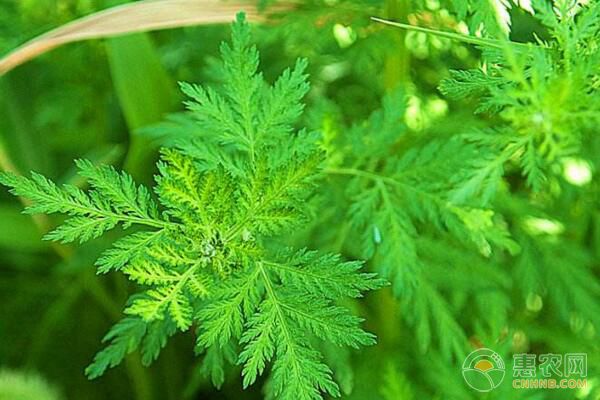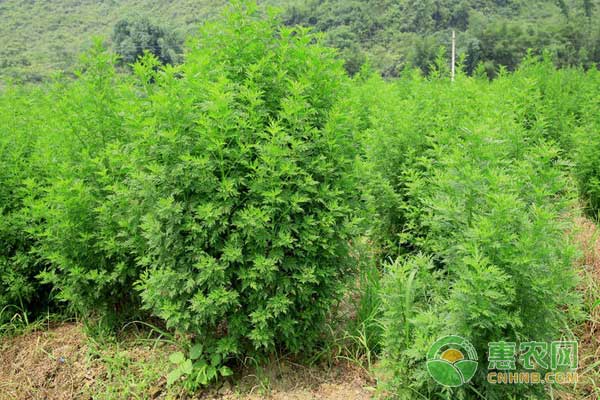Main cultivation techniques of Artemisia annua L. and pest control
How to plant wild herbs, Artemisia annua? The scientific name of Artemisia annua L. is called Artemisia annua L., and the medicinal material Artemisia annua L. is the dry aerial part of Artemisia annua L., which is bitter, spicy, cold, and has liver and gallbladder. It has clear heat, removes bone steam, relieves heat, removes malaria, and yellows. Efficacy, for warm evil wounds Yin, night heat early cold, yin deficiency fever, bone steaming heat, summer heat fever, malaria cold heat, damp heat jaundice, but spleen and stomach weakness, intestinal slippery diarrhea are not allowed.

1 Wild domestication of Artemisia annua
1.1 variety selection and seed treatment
Artemisia annua is a 1-year-old herb that breeds on seeds. The plants have aroma, flower heads, flowers are all yellow tubular flowers, the outside is male flowers, the inside is bisexual flowers, all solid, achenes oval, hairless, pale green. In the south of Henan Province, the wild Artemisia annua L. seeds mature in mid-to-late October, and seeds are suitable for harvesting from late October to mid-November. China's wild Artemisia annua L. is rich in resources, and it can screen out the high yield of artemisinin by domestication of wild resources and is suitable for planting high-quality varieties in southern Henan. When domestication of wild Artemisia annua L., wild species with many branches, tight cotyledons, tall and strong plants, high yield, comprehensive stress resistance and high artemisinin content should be selected.
Artemisia annua seeds have no dormancy period, no special treatment is required before sowing, and the suitable germination temperature is 18~25°C. Artemisia annua L. can be grown in the spring, summer and autumn of southern Henan, but Artemisia annua L. is a strict short-rooted shallow root plant with short roots and developed lateral roots. It is moist, avoids drought, is afraid of waterlogging, and has sufficient light requirements. Summer and autumn. Planting due to vegetative growth time is too short, plant growth can not reach a certain amount of biomass and flowering results, affecting the yield and quality of medicinal materials, southern Henan is suitable for spring when the temperature is 10 ~ 25 °C. Artemisia annua seeds are small and thin, about 1mm long, which can be broadcasted and seeded and transplanted. It is better to transplant seedlings on production.

1.2 seedling transplanting
1.2.1 Nursery
Artemisia annua L. is suitable for growth in a warm, humid, well-ventilated environment. It is best to choose a field with deep soil, fertile soil, good water permeability, good drainage conditions, and leeward sun. The low-lying, soil-heavy fields are not suitable. Selected as a nursery. In the south of Henan Province from mid-February to mid-March, when the average daily temperature is stable above 10 °C, seedlings can be nursed, and the ratio of nursery to field is roughly controlled at 1:20. Before the nursery prepares the land, it will apply sufficient organic fertilizer, plow the land, cultivate the soil and level it, and smash it. The creping standard is 15~20m long, 1.1~1.2m wide, 0.4~0.5m wide, and 0.15~0.20m deep. The ditch is straight. The soil was loosened once before sowing, and the soil of the knead noodles was leveled and smoothed, and the soil of the seedbed was irrigated, so that the bed soil of 5 cm deep was soaked, and the seedlings were planted at a row spacing of 10-15 cm. The seeds of Artemisia annua L. are small, and the seeds and grass ash (fine soil or fine sand) are mixed at a ratio of 1:1 000, and the tillers are quantitatively, uniformly and repeatedly sown, and then covered with a layer of ash, which is immersed in water and moisturized after sowing. When the seedlings grow 3~4 pieces of true leaves, the seedlings are planted, and the dense seedlings, thin seedlings, diseased and infected seedlings, long seedlings and deformed seedlings are properly removed, and the seedlings and weeds of other varieties are removed, so that the air circulation and sunshine are sufficient between the seedlings. Strong growth. When the seedlings grow to 5~7 pieces of true leaves, they can be transplanted and planted in the field.
1.2.2 transplanting
According to the growth habits of Artemisia annua L., the transplanted fields should be selected from sandy loam or clay loam with deep sun, deep soil layer, loose texture, medium fertility and high water retention and fertility. After selecting the ground, it is necessary to finely dig the ground, plow 25~30cm, smash the clods, apply 15000~22500kg of organic fertilizer per hectare or base fertilizer of NPK compound fertilizer, and then plow the soil once, so that the soil is soft, fine and smooth, soil and fertilizer Mix evenly and finally squat. The starting standard is 0.8m wide, the ditch is deep and smooth, the ditch width is 0.4~0.5m, and the ditch depth is 0.3~0.4m. When the seedling age is 50 days, the leaves are 10~15 pieces and there are more than two branches, the transplanting is the best. The suitable transplanting period is from early to mid-April, and no later than May. When transplanting, the seedlings do not have soil, the leaves are not constricted, implanted along the roots, and the plants are planted with water. After the rain, choose cloudy or sunny afternoon transplanting, and plant the root water after planting. The transplanting density of the field with high fertilization level was 30,000-37,500 plants/ha, and the transplanting density of the field with moderate fertilization level was 45,000 to 52,500 plants/ha.
1.3 Field Management
After 7 to 10 days of transplanting, check the seedlings to fill the gap, use a small shovel to take the soil to replant the seedlings, and transplant the roots after transplanting. The first cultivator should be carried out in a timely manner. The cultivating should be shallow, and the plant can grow slightly deeper. According to the growth and development of the plant, the topdressing, watering and drainage should be carried out in time, and then the cultivating and weeding should be carried out 2~3 times before the closure. The principle of fertilization is based on organic fertilizer, supplemented by chemical fertilizers; based on base fertilizer, supplemented by topdressing, combined with nitrogen, phosphorus and potassium; the land with insufficient base fertilizer, suitable for topdressing at the right time. The nitrogen fertilizer applied in the seedling stage may be slightly more, and the phosphorus and potassium fertilizer should be gradually increased during the later growth and development. A topdressing was carried out 7 days, 1 month and 2 months after transplanting. The ratio of NPK was 1:2:2. The method was to dig a hole between the two plants and put the fertilizer into the hole and cover the soil. When the plant grows to a height of about 1 m, the top 0.5 cm tender tip is removed, which promotes multiple collaterals and increases yield. Watering in a timely manner during the dry season to keep the soil moist. In the season when there is more rain, the water is removed in time, and related drugs are sprayed to prevent the occurrence of pests and diseases.

2 Pest control
Wild Artemisia annua L. pests and diseases are rare, and domestication and cultivation usually do not require pest control. When planting in heavy field, attention should be paid to the prevention and control of diseases such as root rot, stem rot, powdery mildew and pests such as aphids, mites and small tigers. Pest control: The prevention and control of Agropyron pests and diseases is mainly based on agricultural control, timely drainage in continuous rainy days, and low-toxic, high-efficiency, residue-free pesticides should be used for drug control. Partial sprays such as avermectin, sputum or trichlorfon can be used. Drugs control pests.
3 Harvesting and processing
Artemisia annua L. is mainly harvested, and the beginning of the bud (10% of the plants in the field) is the best harvest period. According to the growth of Artemisia annua L., it can be harvested after July 20 and harvested before September. Choose a sunny afternoon, cut the main stalk about 30cm from the ground, and take back the natural drying in the afternoon of the next day, knock down the leaves, and continue to dry the leaves until the sun touches the hand to grasp the feeling. In the case of continuous rainy days during harvesting, drying treatment should be taken in time to prevent mold and leaf rot. The harvested net leaves or leaves with leaves are dried or dried, and the water content is below 10%. It is better to have no branches, no impurities, no dead leaves, no mold leaves, and aroma is greenish orange. Generally, the yield of wet Artemisia annua L. is 30,000~45000kg/hm2, the drying rate is 10%~12%, and the dry product can be produced at 3,000~4 500kg/hm 2 .
The above is the whole content of the cultivation of Artemisia annua L., and interested farmers can learn more about it, and more exciting content can continue to pay attention to this site!
For more exciting pictures and popular comments on the technology of Artemisia annua L., click below to see more original ↓ ↓ ↓
Document preservation is an indispensable and important link. There are many types of documents in the office, some are company financial data, some are employee personal data, some are contract agreements, etc. The office safe is a good choice to protect the safety of these files, and play a role in keeping and storing files.
Office safes produced by our company are made of high quality solid alloy steel with excellent anti-drilling and anti-smashing properties, equipped with solid locking bolts and thickened door panels to provide physical protection against forced entry.
This office safe of different sizes has different interior Spaces. Safes of 35cm and above are equipped with movable and adjustable shelves, multi-functional hooks and private inner cabinets, giving you more choice and more flexible storage space.
Our 25cm height and above safes feature a dual alarm system that automatically activates after 3 consecutive incorrect password or fingerprint input and vigorous vibration, with an alarm sound of more than 70 decibels for 60 seconds, and you can hear it in every corner of your home.
Office Fingerprint Safe Box,Office Electronic Safe,Wholesale Office Safebox,Documents Safebox
Hebei Hupai Aodi Cabinet Industry Co.,Ltd. , https://www.hupaiaodi.com